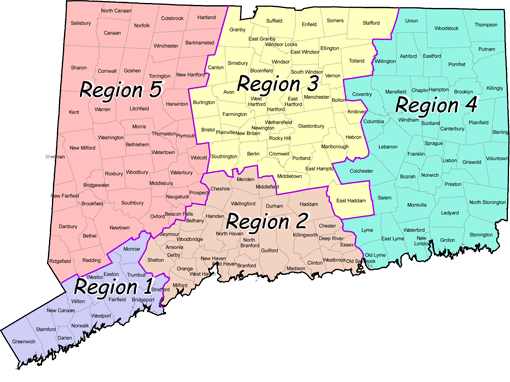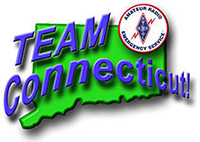The American Radio Relay League has 15 Divisions covering all 50 states, the District of Columbia, Puerto Rico and the US Virgin Islands. Each Division is further broken down into Sections. Larger states may be divided into multiple Sections but most states, like Connecticut, is a Section onto itself. Connecticut has been further subdivided into five Districts that align with those created by the Department of Emergency Services and Homeland Security (DEMHS).

Each of these 5 Districts has a District Emergency Coordinator (DEC) appointed to oversee operations there. An additional DEC has been appointed to coordinate the SKYWARN program of the National Weather Service. Other special DEC’s may be appointed to work specifically with the Red Cross, National Traffic System, or Special Operations.
Assistant District Emergency Coordinators (ADECs) are assigned leadership roles in subsections of a Region to handle special projects within a Region. The report to he DEC for that region.
Emergency Coordinators are appointed by the District Emergency Coordinator to work in specific towns or localities within their District. All appointments are subject to the approval of the Section Emergency Coordinator (SEC) and the Section Manager (SM) who is the elected head of the Connecticut Section Field Organization of the American Radio Relay League.
If you click on the various positions listed below, they will describe the qualifications and requirements needed for the position.
Towns in Region 1 and their ECs
Southwest part of the state
Towns In Region 2 and their ECs
South Central part of the state
Towns In Region 3 and their ECs
North central part of the state
Towns In Region 4 and their ADECs
Eastern part of the state
Towns In Region 5 and their ECs
Northwest part of the State
How Does It Work?
Usually we’ll first hear about a situation just like everyone else – on the news. If not, a call will be placed to the SEC or a DEC from the State OEM or Red Cross asking for aid. Information about what is needed, where and when is gathered. This information is passed on to ARES leaders using whatever communications means are available, most often phone or via linked VHF repeaters.
Local radio nets are established in each district on planned frequencies and one or more nets are set up for overall state coordination. This will include the use of HF, UHF/VHF and packet modes. The SEC coordinates all movements of volunteers and equipment through the state. The DECs will set up marshalling sites in the affected areas, make their needs known, and log in all teams coming into the area to give aid.
WHAT IF I JUST SHOW UP?
Given the current requirements of emergency aid and the probability that it will also be a crime scene, people who just show up without going through and being properly assigned and documented at the marshalling areas will probably end up arrested!
ARES volunteers can expect to be assigned to Emergency Operations Centers, shelters, mobile units working on tactical and logistical problems, hospitals and clinics, triage areas, and provide communications for critical agencies who do not have compatible radios of their own. You may be in an office or out in a parking lot. Our strength is our ability to set up most anywhere we are asked to help.
The CT ARES Leadership Council
Current members of the CT ARES Leadership Council (CALC) are:
| The person in charge of everything in the Section is the Section Manager (SM) | |
| The Section Manager (Douglas Sharafanowich, WA1SFH) is an ex officio member of the CALC; | wa1sfh@optonline.net |
The SM may have several assistants:
| Betsey Doane, K1EIC; Assistant Section Manager (ASM) | k1eic@arrl.net |
| Wayne Gronlund ,N1CLV; Assistant Section Manager (ASM) | n1clv@mac.com |
| The Section Manager also appoints leaders, in addition to the SEC, to coordinate other functions within the Section. | |
| Mike Sperber, K1NAS – Hartford Area Public Information Officer (PIO); | masperber@gmail.com |
| Anne West, K1STM – Section Traffic Manager (STM); | k1stm.ct@gmail.com |
| Douglas Sharafanowich, W1SFH – Section Youth Coordinator (SYC); | wa1sfh@optonline.net |
| Steve Simons, W1SMS – Technical Coordinator (TC); | ssimons@manitousys.com |
| Larry Buck, K1HEJ – Welcome to New Hams; | k1hej.buck@gmail.com |
| The person responsible for all the ARES work in a Section is the Section Emergency Coordinator (SEC). | |
| Phil Crombie, K1XFC – Section Emergency Coordinator (SEC) – leader of the team, and overall operational coordination; |
k1xfc@arrl.net |
| Because this is a major job, the SEC will often also have one or more assistants: | |
| Rod Lane, N1FNE – Assistant SEC; | n1fne@arrl.net |
| Wayne Gronlund, N1CLV – Assistant SEC; | n1clv@mac.com |
| Chuck Rexroad, AB1CR – Assistant SEC; | ab1cr@arrl.net |
| The District Emergency Coordinators: | |
| DEC (Region 1) Peter Cimino, K1PCN | fowlpox@gmail.com |
| DEC (Region 2) |
| DEC (Region 3) Bill Storey, AB1LZ | wtstorey@aol.com |
| DEC (Region 4) ; |
| DEC (Region 5) Harlan Ford, W1QH hford01@snet.net |
| DEC SKYWARN – Steve Williams, K1SJW | k1sjw@arrl.net |
Official Emergency Stations assigned to management responsibilities may be included at the discretion of the SEC. These appointees may also be included at ARES leadership meetings at the request of the SEC.
